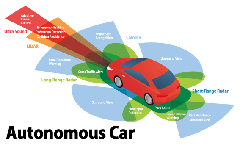 Light detecting and ranging (lidar) sensing technology is employed in a wide range of industries. This includes oil/gas exploration, solar energy, gaming, meteorology to automotive, defense, robotic mining, aerial/terrestrial scanning, roadway design, laboratory testing, law enforcement, agriculture. Lidar utilizes light waves from a pulsed laser beam (up to 150,000 pulses per second) to calculate distances to a target. This measurement is determined by how long it takes the reflected light to return to the sensor located within the lidar module. Lidar outperforms radar and sonar by operating light waves instead of sound or radio waves.
Light detecting and ranging (lidar) sensing technology is employed in a wide range of industries. This includes oil/gas exploration, solar energy, gaming, meteorology to automotive, defense, robotic mining, aerial/terrestrial scanning, roadway design, laboratory testing, law enforcement, agriculture. Lidar utilizes light waves from a pulsed laser beam (up to 150,000 pulses per second) to calculate distances to a target. This measurement is determined by how long it takes the reflected light to return to the sensor located within the lidar module. Lidar outperforms radar and sonar by operating light waves instead of sound or radio waves.
Job proven lidar technology consists of a transmitter, receiver, detector to generate accurate, precise 3D representations sometimes called 3D laser scanning. High resolution lidar mapping is collected at a rapid sampling rate and is meticulously exact.
Multiple Master Bond customized polymeric formulations have been compounded to produce dependable, reliable solutions for high precision assembly of lidar remote sensing systems. Master Bond's team of highly experienced engineers has the technical expertise to enable manufacturers to accomplish extremely difficult complex goals for advanced lidar capabilities in compact sizes and weight. Several innovative lidar designs have been augmented through applying unique Master Bond adhesive compositions for die attachment, lens bonding, EMI shielding, electrical conductive connectivity, low stress, gap filling thermal interface materials for interfacing fragile components. Essential contributions have also been made for protecting these versatile systems from adverse environmental conditions such as vibration, mechanical shock, thermal cycling, dust, dirt, water ingress, corrosive chemicals, thermal degradation. This has been attained from our wide selection of potting/encapsulation compounds, liquid gasketing sealants, board level underfills and conformal coatings. Particularly noteworthy has been the successful deployment of our single component, fast curing UV compounds for attaching a lens to a lens barrel, dual UV/heat curing products to guarantee alignment of vital components prior to final polymerization at low temperatures and substituting adhesives for soldering for attaching indispensable components.
Sophisticated lidar technology has the potential of being transformative for manufacturers of self-driving autonomous vehicles. As they become more accessible, the future impact of mobility will have a tremendous impact on how we live and function in society. Some of the chief attributes emanating from replacing manually driven vehicles span from saving lives by reducing the number/severity of auto accidents, lowering fuel consumption /CO2 emissions, noise pollution, decreasing traffic congestion/effects of rush hours, require extensive computer programming to create new jobs, employment of older/disabled people unable presently to commute to work, shorter travel times, more efficient parking. While enormous technical, legal, social challenges remain, new progress has made considerable strides forward to fulfill the magnificent opportunities these vehicles offer.

